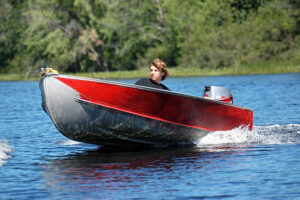
Before the arrival of cold weather, you’ll want to winterize your boat. Choosing a boat storage option is merely the beginning of the preparations for your prized possession’s winter hibernation. Even if you utilize your boat throughout the winter, which we highly recommend, there are still a few systems and components onboard that require special care.
You’ll be ready for winter if you follow a few of these tips. The manufacturer’s suggestions for winterizing and other systems in your boat should not be ignored while reading your owner’s handbook. If you have no prior experience with winterizing your home, or if you do not have an experienced friend you can turn to for help, hire a professional.
Tips and Tricks to Winterize Boats
Adding antifreeze and a gasoline stabilizer isn’t enough to winterize a vehicle properly. From the bow to the transom, it’s an exact procedure. First, consult your owner’s manual’s winterizing/storage section due to the wide variety of boat and engine configurations.
Fiberglass is designed to withstand the rigors of heat and saltwater in the summer, so shouldn’t a little snow be a problem? Wrong. Ice can build up and cause holes in hatches and window tracks. A good boat cover is thus required for outside storage.
You’ll also want to inspect the hull for stress fractures and Gelcoat blisters, which are typically around the bow eye. Stress cracks can indicate structural deterioration, and a boat specialist should investigate this. Blisters are punctured, drained, dried, and then patched with an epoxy-based filler explicitly produced for this purpose using a drill. If your boat’s hull is aluminum, use a rubber mallet to hammer out any dents gently.
Applying Gels and Sprays
Vinyl interiors can suffer in humid and dry conditions throughout the winter months. Gels and sprays for vinyl cleaning and protection can help keep your vinyl from cracking and drying out. Mildew thrives in warm, humid environments, making moisture an even more pernicious threat. With the spring, more than one boat owner has opened their boat’s zipper only to discover the interior covered in mold and mildew. As a workaround, ensure that you have sufficient ventilation via the openings in your boat cover. Chemical dehumidifiers that remove excess moisture from the air, as well as anti-mildew sprays, can be of great use.
Moisture corrodes the electronics and electrical systems within. Your non-marinated wire is especially vulnerable to corrosion, which may lead to shorts, blown fuses, and a high repair bill to match. Disconnect all your electrical devices and let them overwinter in a more gentle atmosphere during the winter months. Next, use a moisture-displacing lubricant to coat any exposed electrical connections. You should thoroughly clean all bright work, carpets, and decks at this time, as well as a general grime-busting mission.
Boat Cover
Before storing it, you should thoroughly clean and dry your boat’s detachable head. Antifreeze should be injected into built-in equipment, such as sinks and showers, to prevent them from freezing ways Winterize your boat.
When purchasing a boat cover, be sure it protects the waterline. Polytarp coverings are reasonably affordable, but they must be used with a frame to carry the workload of snow uniformly and away from the boat’s weak spots. PVC tubing or 2 x 4s can be used to build a frame. In addition to ready-to-assemble kits, you may also purchase pre-assembled aluminum tubing frames with clamps that allow you to join the tubes at any angle.
It’s possible to utilize banding along the ridge of the chassis in place of 2x2s or 2x4s. The strapping is thin enough to bend, resulting in a smooth arch that helps form the shrink film. This approach will deflect water, snow, and ice more effectively. You may need to use two layers of strapping in locations with more snow, as the first layer is typically tangled and fragile. As it is quicker to dismantle and reassemble the frame using screws, use them instead.
They are commonly utilized because of their high water repellency and resistance to mildew and spotting. This will prevent snow from blowing below and tearing the cover if it’s not adequately secured.
When properly fitted, shrink wrap will protect your boat from heavy snow and falling debris that may otherwise dislodge a tarp. It’s another option for boat protection.
Check the motor.
Fuel deterioration and freezing are the main threats to engines throughout the winter months. Pull the engine cover off and inspect the cables, connectors, and clamps for fraying or looseness. All hoses should be inspected and replaced if they are mushy or show signs of cracking. The belts should be inspected, and the tension adjusted if necessary. Prevent corrosion by repairing any nicks in the paint. Take a few minutes to warm the engine up, and then change the oil and the filter ways to winterize your boat. Board motors come equipped with a connection for a garden hose to make things easier. Reverse flushing outboards and stern drives may be done using “earmuffs.” Keep the engine running until the water is clear, ensuring it doesn’t overheat when flushing.
Wire-clean all outboard telltales and store the engine vertically to ensure that all water drains away. Any remaining water in the engine might quickly freeze and cause significant harm. To prevent ice pockets from accumulating and cracking the block, you must refill propylene glycol antifreeze inboards and sterndrives.
- Jet clogs and injector stickiness are caused by the heavier gasoline fractions, creating a varnish while the lighter fractions evaporate away during storage. Due to the deteriorating activity, the fuel’s octane rating drops within two weeks. Idle the engine for ten to twenty minutes after adding a gasoline stabilizer to ensure that the stabilizer is evenly distributed throughout the system.
- Remove the engine’s flame arrestor and spray fogging oil down the carburetor while running to protect the engine’s internals from rust and corrosion. Turn off the carburetor/fuel injection system by closing the fuel valve or pinching the fuel line to burn up any residual fuel. Squeeze some fogging oil into the cylinders when the engine is at a standstill. Reinstall the plugs after rotating the engine a few times to ensure a proper oil coating. Alternatively, the ignition can be disabled while the engine runs, and fogging oil is injected down the carbways to winterize your boat.
If even a dab of fuel is left in the carburetor, it can cause the main jets to get clogged. You must remove the carburetor drain plug to withdraw the whole gasoline supply.
- Securing an anti-ventilation plate between a piece of wood and the prop nut will allow you to remove it from the stern end of the boat. Check if the prop, hub, and splines are in good shape. An impeller replacement is inexpensive insurance against a water pump breakdown in the future.
If the gear case lubricant turns milky, there is water in the oil, which you must drain. Metal chips are another sign that your gears work harder than your engine.
Spending less time on the trailer and more time enjoying your boat in the spring is the goal of diligent winter maintenance.
Visit the Boat
Make regular visits to the boat to run the engine and recharge the batteries. After 30 minutes of running, you should wait 20 minutes before shutting off the engine. This will enable acidic condensation to build up and undermine the purpose of using clean oil and a filter in the first place, ways to winterize your boat.
It’s also a good idea to clear the cockpit drains and bilge pump drainage lines of leaves while you’re there. To ensure the mooring and boat’s condition are not deteriorating, vessels should not be neglected for extended periods.
Conclusion
Boat winterization is not tricky, but we must warn you: You might end up with an engine replacement cost of at least $2,000 for missing a drain plug or not following the proper procedure. And insurance won’t cover any of that. If you’re apprehensive about winterizing your boat, get a manufacturer’s service manual to help you find all the drain ports and cooling systems.
You should purchase a couple of gallons of RV antifreeze, fogging oil, motor oil, an oil filter, lower unit lube and drain plug gaskets, an oil suction pump, and a lower unit lube injection pump before beginning the winterizing operation. Once you’ve gathered all of your tools, it’s time to go to work ways to winterize your boat.






